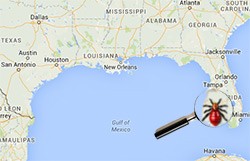Tampa, St. Louis, and Orlando Remain the Top Cities for Malware in the First Half of 2015
 Malware infection rates in Tampa, St. Louis, and Orlando had more than three times the national average in the first half of 2015. That's according to data released today by ESG research team, makers of the SpyHunter anti-spyware product. We analyzed more than four million different infections on computers in the 150 largest cities in the U.S. The cities with the most infections per capita were Tampa, St. Louis, and Orlando. Denver and Atlanta rounded out the top five.
Malware infection rates in Tampa, St. Louis, and Orlando had more than three times the national average in the first half of 2015. That's according to data released today by ESG research team, makers of the SpyHunter anti-spyware product. We analyzed more than four million different infections on computers in the 150 largest cities in the U.S. The cities with the most infections per capita were Tampa, St. Louis, and Orlando. Denver and Atlanta rounded out the top five.
"It's interesting to see how the infection rate varies from city to city," said Patrick Morganelli, Senior Vice President of Technology at ESG. "For example, the infection rate in Tampa was five times that of the average infection rate in the top 150 cities. St. Louis' infection rate was nearly four times the average."
ESG compiled similar statistics at the end of 2014. Just like the end of 2014 going into the first of 2015, Tampa remained to stay at the top of the list throughout the first half of the year. Salt Lake City dropped out of the top five while Denver replaced it. The city that saw the biggest spike in infections per capita was Buffalo, which went from number 47 overall for 2014 to number 18 overall so far in 2015.
Some may ask, what makes one city have higher than normal infection rates? Morganelli says that is very hard to tell. Morganelli goes on to say, "I wish there was an easy way to determine what makes people in one area more susceptible to malware infections." To boot, there are so many different ways that infections can end up on computers, which makes it extremely difficult to make any generalizations about why certain folks in certain cities seem to have infections than others. One potential reason for Buffalo's spike could have been the harsh winter they experienced with much colder than normal temperatures to start out the New Year. Anytime there are more people staying inside because of the weather, there's greater chance they'll be online and putting themselves at risk for infection.
One of the most common ways malware infections end up on computers is from websites that contain infected content. Usually, such sites will entice users with various popups or simply ask users to download tempting files that contain infected content. In most situations the culprit web pages are adult websites. Users are often asked to download updates to their web browser video players so that they can watch adult videos. Instead of downloading an update, the user unknowingly downloads an infection that automatically installs.
"We're not saying that people in Tampa, Orlando, and St. Louis are visiting more adult websites than people in other cities," Morganelli says. "But that still is one of the biggest sources of the malware that our software detects."
The other biggest source of malware infections is when people are tricked into clicking on links that either download malware or take them to a web site that has malware on it. Those links can come in the form of emails that look like something legitimate, or better yet, in social media messages that have been hijacked by hackers.
"Because of the growth in online communication - be it Facebook, Linkedin, Twitter, Pinterest, Instagram or other social networking platforms, there are now more ways for cybercriminals to reach out and trick people into clicking on links," Morganelli said.
"The best way to protect yourself is to have a trusted anti-virus and anti-malware program installed and updated regularly. We obviously recommend SpyHunter," said Morganelli. "Then, it's always best to think about that link. Before you click on something in an email or social media message, think for just a couple seconds about whether what you're looking at is too good to be true or seems a little suspicious. Exercising just a little extra caution could help keep you from getting infected."
Below is a list of the top 20 cities with the most infections per capita, along with how much higher their infection rate was compared to the national average. Each city's rank in the 2014 end-of-year stats is in parenthesis.
Top Cities for Malware Infections in the First Half of 2015
- (1) Tampa 506% higher than the national average
- (3) St. Louis 392% higher than the national average
- (2) Orlando 375% higher than the national average
- (6) Denver 333% higher than the national average
- (4) Atlanta 327% higher than the national average
- (7) Newark 241% higher than the national average
- (5) Salt Lake City 223% higher than the national average
- (8) Madison, Wisconsin 193% higher than the national average
- (9) Cleveland 184% higher than the national average
- (11) Cincinnati 170% higher than the national average
- (10) Little Rock 164% higher than the national average
- (12) Washington, DC 162% higher than the national average
- (13) Miami 114% higher than the national average
- (17) Raleigh 98% higher than the national average
- (15) Irvine, CA 96% higher than the national average
- (14) Pittsburgh 87% higher than the national average
- (47) Buffalo 87% higher than the national average
- (18) Minneapolis 85% higher than the national average
- (16) Richmond, Virginia 81% higher than the national average
- (19) Seattle 72% higher than the national average